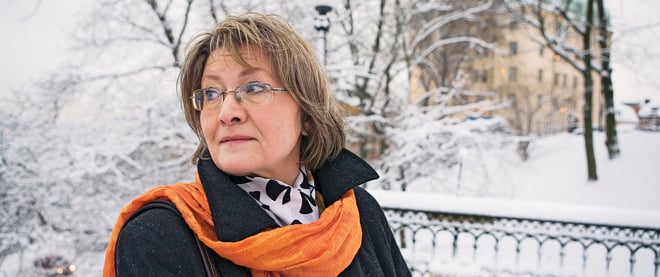The wife with the angry memoir
Stieg Larsson’s widow settles the score, if not the bank account, with her raw tell-all
Elin Berge/Moment/Redux
Share

Millennium Stieg, as Stieg Larsson’s widow Eva Gabrielsson, 57, disdainfully refers to the celebrity afterlife of her common-law husband of 32 years, is still going strong. Seven years after the Swedish writer’s death, sales of his crime novels, The Girl With the Dragon Tattoo and its two sequels—collectively known as the Millennium trilogy—have topped 40 million copies worldwide. Far from fading, the buzz is only going to increase. The Hollywood version of the first book, starring Daniel Craig and Rooney Mara, which bills itself as “the feel-bad movie of Christmas,” reaches theatres in December; and “There Are Things I Want You to Know” About Stieg Larsson and Me—Gabrielsson’s long-awaited version of her Stieg, her bitter dispute with Larsson’s family, and her take on the much-rumoured fourth volume—will be in bookstores this month.
Gabrielsson’s book is compelling: in places poignant (her life with Larsson) or raw (the immediate aftermath of his fatal 2004 heart attack), and in others, uncomfortably self-aggrandizing. In Gabrielsson’s account, Stieg poured their common life, from their upbringing in northern Sweden to their joint leftist and feminist advocacy, into the trilogy. “I cannot tell exactly what part of the Millennium trilogy comes from Stieg and what comes from me.” It may have been his fingers on the keys, but the story is theirs: she, and only she, Gabrielsson argues, could finish Larsson’s work. Whatever its merits as a memoir, There Are Things I Want You to Know is also a weapon, deliberately crafted and wielded, in the widow’s war with the Larssons.
Stieg, a mostly penniless investigative journalist dedicated to battling far-right extremism, and Eva, a scarcely better off architectural planner and writer, did share everything for three decades, including their one solid material possession (a 600-sq.-m Stockholm flat), and the dangers posed both by Stieg’s violent political enemies and by Swedish law. They had practical reasons not to marry or have children. In the 1990s neo-Nazi groups murdered more than a dozen people in Sweden, including journalists; such incidents in the trilogy were drawn from real life, Gabrielsson writes: “nothing was made up.” If Eva and Stieg had wed, she would have been linked to him in publicly available databases, and so it was safer for Eva that Stieg be listed as “single” in official documents.
They paid no attention to the potential downside of that decision. To the astonishment of foreigners, still in thrall to the idea of Sweden as a paradise of gender equality, Swedish law does not recognize common-law marriages, including the inheritance rights of spouses. Larsson died intestate, and anger at his carelessness—about his health (60 cigarettes, 20 cups of coffee and plentiful junk food daily) and about Eva’s future—is a muted but undeniable theme through the book. At his death Gabrielsson lost everything: her partner, the tens of millions of dollars soon to flow from the trilogy, control over the books (Stieg, she writes, would not have wanted film versions), even—insult added to injury—ownership of half their flat. It all went to Erland Larsson, Stieg’s father, and Joakim Larsson, his brother. Stieg, according to Gabrielsson, was estranged from both.
What was left in legal limbo, because it contained the names of confidential informants, was Larsson’s laptop. (Swedish law, in the protection it offers journalistic sources, came down on Eva’s side this time.) For Larsson’s fans, of course, it’s what else may be on the computer that matters. Is there enough of a book four for someone to complete it? Gabrielsson is coy about where the laptop is, but provides, barely, enough information about the story on its hard drive to whet fan interest: Larsson’s hacker heroine Lisbeth Salander “gradually breaks free of all her ghosts and enemies.” As all trilogy readers know, this liberation will not be achieved by talk therapy or mediation; indeed, the volume is entitled The Vengeance of God. She could finish it, Gabrielsson repeats, making it clear that no one else will have a chance to do so unless she prevails in her battle with the Larssons for moral control over Stieg’s literary legacy. Call it the Vengeance of Eva.